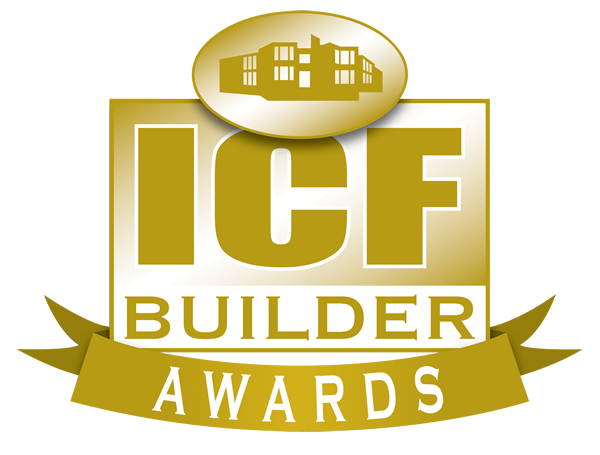
When ICF promoters list the benefits of ICFs, noise dampening is usually little more than an afterthought. But it can be a major selling point. Theaters, apartment buildings, and developments near noisy industrial sites are just a few examples of when sound attenuation should become a major selling point.
Those who live in ICF homes list sound attenuation as one of the most appreciated benefits. About 10 years ago, Pieter VanderWerf surveyed 75 ICF homeowners about the features they appreciated most in their ICF homes. It’s no surprise that energy efficiency and disaster resistance topped the list. But benefits numbers three and four were comfort and quiet. In fact, more than 60% of ICF homeowners mentioned the quietness of their homes, versus only 2% of their wood frame counterparts.
VanderWerf says, “Many homeowners said their biggest surprise in moving into an ICF house was the noise difference… The ICF owners told two common stories over and over again: ‘I looked out the window and saw the traffic on the road, but I couldn’t hear it.’ And ‘While talking with my neighbor one morning, he asked if the thunderstorm the night before woke me up, too. But until that moment I never even realized we’d had one.’ “
Effectiveness
Most ICFs with a six-inch concrete core (10- or 11-inch ICF wall) advertise STC ratings of 50 to 55. A Sound Transmission Class (STC) rating is a measure of how much sound travels from one side of the wall to the other, and is measured in decibels. Uninsulated 2×4 wood stud walls have an STC rating of about 33. Insulated with 3 ½ inches of fiberglass batt, the STC rating increases to near 38.
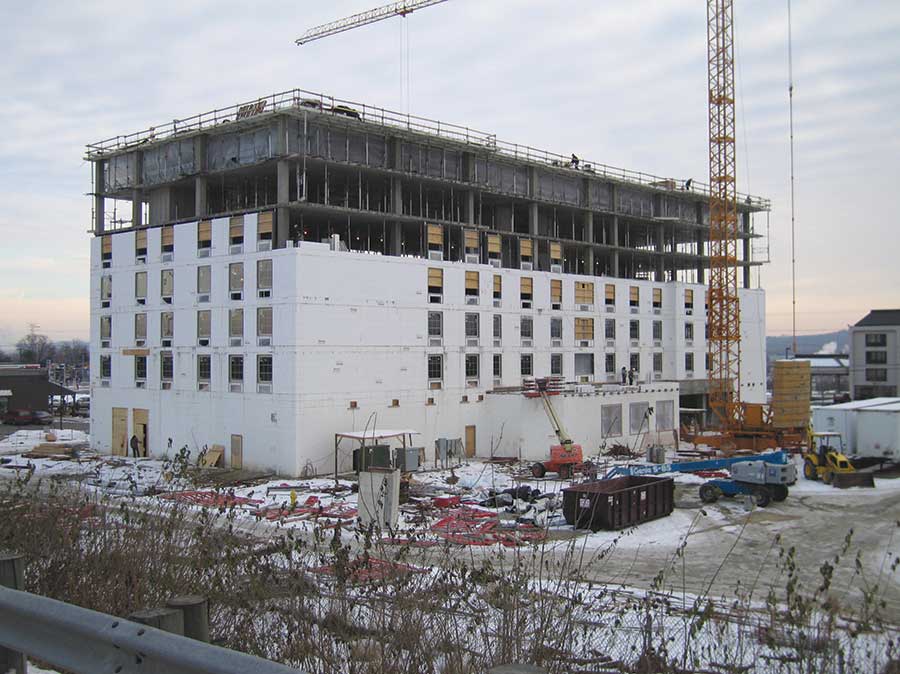
ICFs are popular for hotel construction because they not only quiet exterior noise, but also eliminate noise between rooms.
The difference between an STC rating of 38 and 50 may not seem like much, but the decibel scale is logarithmic, meaning that 50 decibels is ten times as loud as 40 decibels. In real-world terms, only about one-quarter to one-eighth as much sound penetrates an ICF wall when compared to wood frame.
The table above demonstrates how much sound penetrates a wall based on its STC rating.
Loud speech on the opposite side of a frame wall would be “audible, but not intelligible.” On the opposite side of an ICF wall, loud speech would be inaudible, and a listener would have to strain to hear shouting.
Applications: Interior Noise
The fact that ICFs can eliminate sound transmission at virtually no additional cost makes them very attractive for any project in which quietness is a selling point.
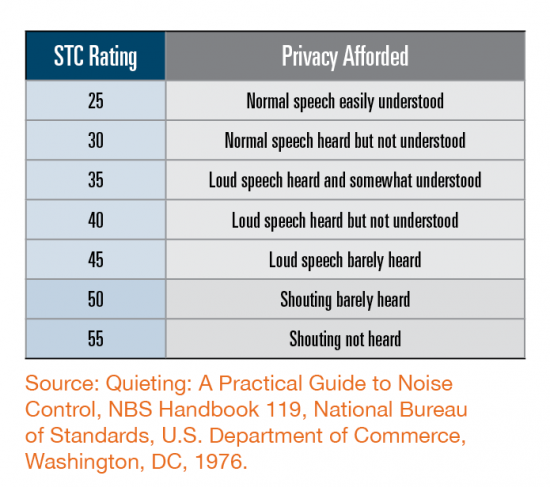
For party walls separating attached dwelling units, U.S. building codes usually require a minimum STC rating of 45. For frame construction, that means two layers of 1/2” drywall on each side, with batt insulation in wall. ICF walls are 10 times more effective, at no additional cost.
Sound dampening is a major reason ICFs are becoming so popular for hotel/motel construction. Dozens and dozens of hotels have been built with ICFs in the past 10 years, using virtually every major brand of form. These include the flagship properties of the nation’s leading hospitality companies, including Marriott, Hilton, Best Western, Holiday Inn, Drury Inn, Super 8, and Motel 6. (For more examples see Hotel Chains Building with ICFs in the Oct. 2010 issue or online at www.icfmag.com.)
Most hospitality projects use relatively large amounts of ICFs. It’s common to use ICFs for all exterior walls, and all interior walls between units and hallways. Many also use ICFs to isolate sound in the exercise and pool rooms.
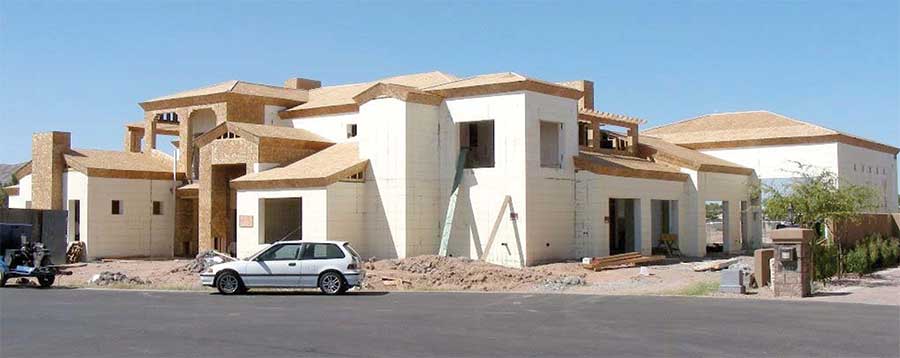
On the Raiser home, ICFs were used to dampen sound between the hangar/garage and living areas. An additional ICF wall between the master suite and the rest of the house isolates it as a sanctuary of quiet.
Years after completion, owners are still raving about the benefits. The owner of an ICF hotel in Texas calls it the “best Hilton Garden Inn in the system.” The manager of the Tifton (Ga.) Comfort Inn calls his property “the best-built hotel in our company.” Drury Inns—the first major chain to use ICFs—is completing a 10 story, 130-foot high hotel in Franklin,Tenn. this fall.
Fast Facts
- Raiser Airpark Home
- Location: Chandler, Ariz.
- 11,257 sq. ft. (Floor)
- 11,000 sq. ft. (ICF wall)
- ICF exterior and demising walls
- 13” IntegraSpec (8” core)
- STC 59
- ICF Distributor: Power Smart Buildings
- Architect: Strong Kennedy Associates
- General Contractor: Ting Lei Associates
- ICF Installer: George Raiser & Mark Ross
In projects like movie theaters, walls need even greater soundproofing. Loud, low-frequency noise is especially difficult to dampen—something most movie-goers have experienced when the quiet scenes in their film are disturbed by the rumbles and explosions from the movie next door.
Very annoying.
For these applications an STC-55 (The standard rating for a 6-inch ICF) is required. But to reach this number, wood frame construction must use a staggered wood stud wall, with a double layer of 1/2” drywall on each side, with 12 inches of insulation in between. With a single curtain wall, installers typically use seven sheets of drywall; three on one side and four on the other. ICFs are usually cheaper, easier, faster, and more effective than either of these solutions, which is why dozens of theaters have been built with ICFs in the last five years.
One of the newest is the 13-screen Frank Theatres Queensgate in York, Pa. Designed by Tom Burdick of ADW Architects in North Carolina, the 210,000 sq. ft. project has over 72,000 sq. ft. of ICF wall, with some of the walls reaching 36’ in total height. The entire perimeter of the building, along with the separation walls between each theater, uses Reward’s 13” iForm.
Burdick took advantage of Reward’s ledge form to create a 4 ½” ledge to support the brick veneer while maintaining a fully insulated wall assembly.
Troy Gibson, marketing director at Reward, says the project was completed in about 10 months—right on schedule—and testing confirmed that the soundproofing surpassed the owners requirements. “We would presume that was a significant savings in terms of labor and materials for the owners,” he says. “All people involved in this project are extremely happy on how their theater turned out.”
Applications: Exterior Noise
ICFs are also an excellent choice for dampening noise from outside the structure, a major factor for homes built near airports, railways, and noisy industrial sites.
In these applications the exterior shell components must be chosen carefully. Unlike demising walls, exterior walls have multiple openings for windows and doors, which can defeat the sound dampening of the rest of the wall. Substandard windows can reduce STC ratings dramatically, as can inadequate roof insulation.
When properly designed, however, ICFs can convert “unbuildable” lots into prime real estate. A classic example is the Villas at Mont Blanc in Halifax, Nova Scotia. The building site, despite the outstanding views, had remained vacant for many years, due primarily to the tremendous amount of noise nearby. A major port, operating 24 hours a day, was less than 150 yards away. A major highway and rail line ran between the port and the building site, and traffic on a nearby major bridge contributed as well. “We knew that if we didn’t do something about the noise, the buildings would be largely uninhabitable,” remembers Peter Polley, the developer.
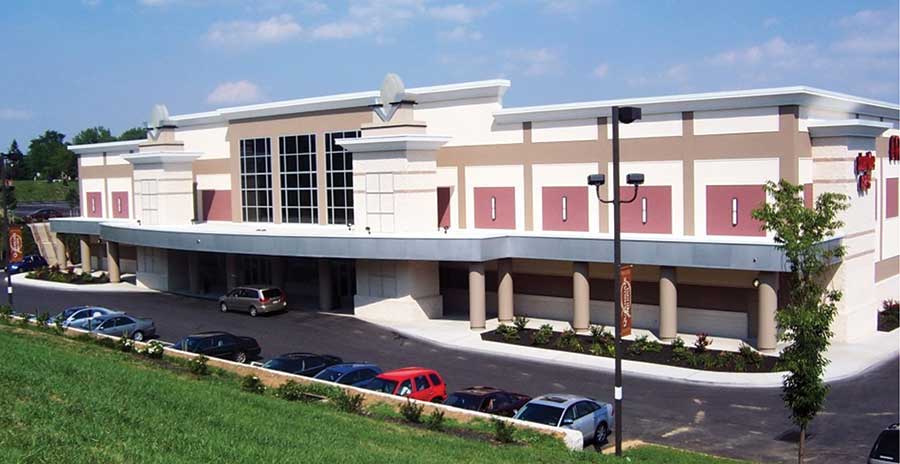
Theater soundproofing is extremely cost-effective with ICF construction. The 13-screen Frank Theatres Queensgate in York, Pa. used more than 72,000 sq. ft. of ICF wall, which virtually eliminates noise transfer
Arxx ICFs, with an STC rating of 50+, solved the problem. Polley reports, “The units are incredibly quiet. It has allowed us to charge premium rents just 400 feet from a major port facility and rail line. If we didn’t have ICF walls we would have serious vacancy and turnover problems, but we’ve been very successful renting the units and keeping the building full.”
A more recent example is the Raiser Airpark Home in Chandler, Ariz., completed in 2009. Built adjacent to a private airport, with an attached airplane hanger, sound attenuation was a must. In addition to exterior walls, ICFs were used for interior walls between the hangar/garage and the living areas, plus an ICF wall between the master suite and the rest of the house. Concrete-EPS decking systems were used on the lower two stories, and spray foam in the roof ensures exterior noise is minimized.
Commercial building owners also recognize sound benefits. When Barry Hess, owner of a NAPA auto parts store in Oregon, learned about ICFs, it took less than a half hour to switch to ICFs from tilt-up.
“The store is located across the street from the Hillsboro [Ore.] Airport and a helicopter training facility,” said Mark Schneider, who provided the Reward ICFs for the project. “They get the noise from both the regular airline traffic and the helicopters all day long, so sound attenuation was a major factor.” According to Hess, with Nike and Intel jets flying right overhead, it would be impossible to block 100% of the noise. But with ICF walls and an R-50 roof, the noise is reduced dramatically. “I believe that what noise we do get is coming in through the roof, not the walls,” said Hess.
Fast Facts
- Frank Theaters Queensgate
- Location: York, Pa.
- 210,000 sq. ft. (Floor)
- 72,000 sq. ft. (ICF wall)
- ICF exterior and demising walls
- 13” iForm by Reward
- STC 56
- ICF Distributor: Construction Supply Center
- Architect: ADW Architects
- General Contractor: Warfel Construction
- ICF Installer: Rubright Construction
Like what you read?
Yearly Subscriptions Starting @ $30

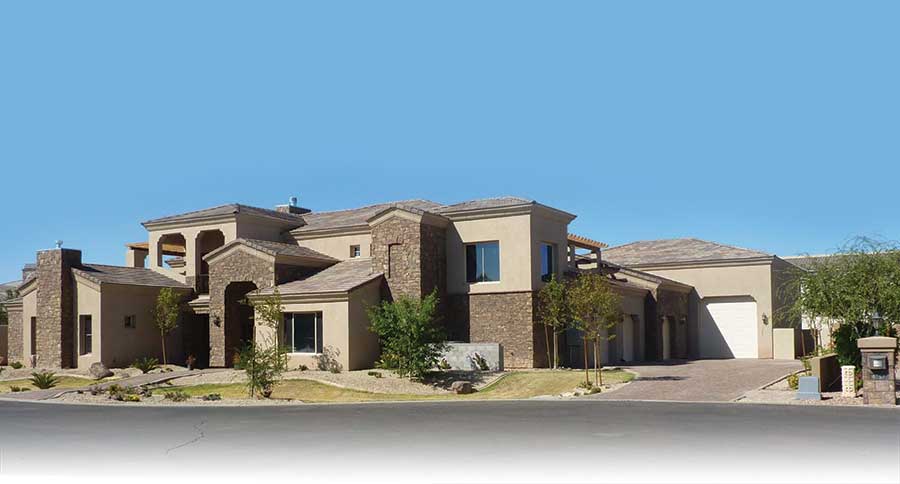
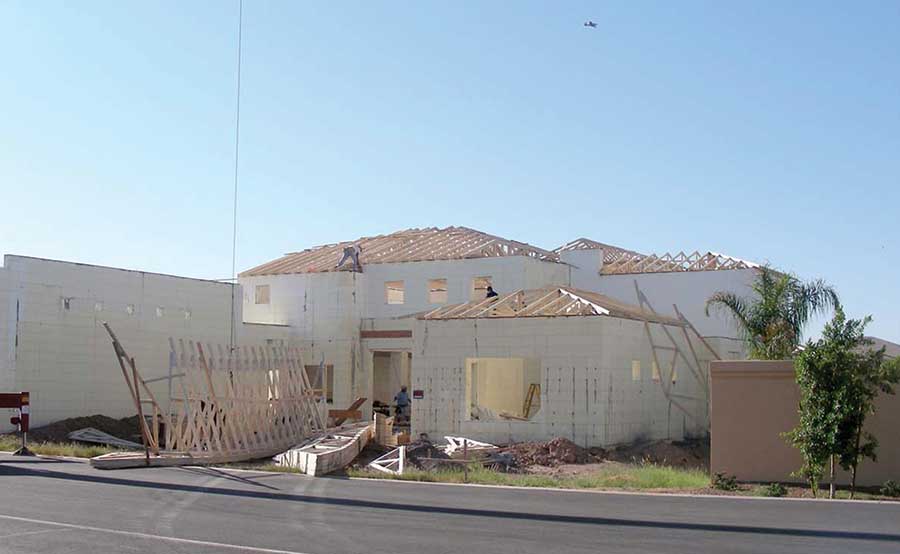

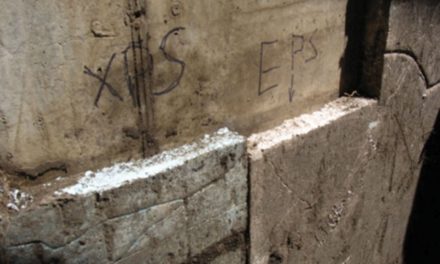

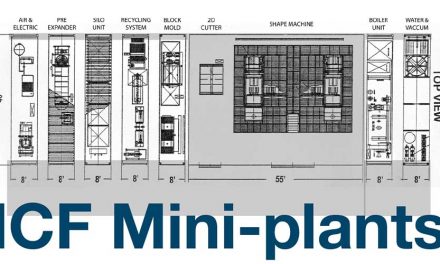
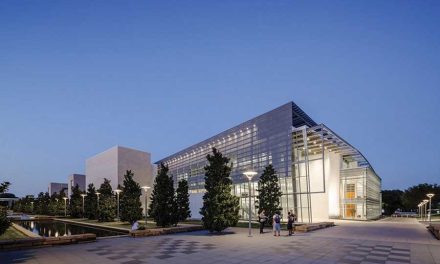








0 Comments